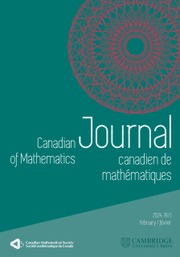Crossref Citations
This article has been cited by the following publications. This list is generated based on data provided by
Crossref.
Fulkerson, D. R.
and
Ryser, H. J.
1963.
Width Sequences for Special Classes of (0, 1)-Matrices.
Canadian Journal of Mathematics,
Vol. 15,
Issue. ,
p.
371.
Fulkerson, D. R.
Hoffman, A. J.
and
McAndrew, M. H.
1965.
Some Properties of Graphs with Multiple Edges.
Canadian Journal of Mathematics,
Vol. 17,
Issue. ,
p.
166.
Fulkerson, D. R.
Nemhauser, G. L.
and
Trotter, L. E.
1974.
Approaches to Integer Programming.
Vol. 2,
Issue. ,
p.
72.
Henderson, J.R
and
Dean, R.A
1974.
The 1-width of (0,1)-matrices having constant row sum 3.
Journal of Combinatorial Theory, Series A,
Vol. 16,
Issue. 3,
p.
355.
Nemhauser, G. L.
1976.
In memory of D. R. Fulkerson.
Journal of Optimization Theory and Applications,
Vol. 20,
Issue. 4,
p.
391.
Lam, Clement W.H.
1977.
The distribution of 1-widths of (0, 1)-matrices.
Discrete Mathematics,
Vol. 20,
Issue. ,
p.
109.
Billera, Louis J.
and
Lucas, William F.
1978.
Polyhedral Combinatorics.
Vol. 8,
Issue. ,
p.
1.
1979.
Inequalities - Theory of Majorization and Its Applications.
Vol. 143,
Issue. ,
p.
531.
Brualdi, Richard A.
1980.
Matrices of zeros and ones with fixed row and column sum vectors.
Linear Algebra and its Applications,
Vol. 33,
Issue. ,
p.
159.
Tarakanov, V. E.
1983.
Depth of (0, 1)-matrices with the same row and same column sums.
Mathematical Notes of the Academy of Sciences of the USSR,
Vol. 34,
Issue. 3,
p.
718.
Baksalary, Jerzy K.
and
Tabis, Zenon
1985.
Existence and constructions of connected block designs with given vectors of treatment replications and block sizes.
Journal of Statistical Planning and Inference,
Vol. 12,
Issue. ,
p.
285.
Soms, Andrew P.
1989.
Some recent results for series system reliability.
Communications in Statistics - Theory and Methods,
Vol. 18,
Issue. 11,
p.
4211.
Aigner, Martin
and
Triesch, Eberhard
1994.
Realizability and uniqueness in graphs.
Discrete Mathematics,
Vol. 136,
Issue. 1-3,
p.
3.
Rajan, R.
and
Agrawal, R.
1996.
Server allocation and routing in homogeneous queues with switching penalties.
IEEE Transactions on Automatic Control,
Vol. 41,
Issue. 11,
p.
1657.
Aigner, M.
and
Triesch, E.
1997.
The Mathematics of Paul Erdös II.
Vol. 14,
Issue. ,
p.
43.
Motwani, Rajeev
1998.
Realization of Matrices and Directed Graphs.
Journal of Algorithms,
Vol. 27,
Issue. 1,
p.
61.
Odijk, Michiel A.
and
van Maaren, Hans
1998.
Improved solutions to the Steiner triple covering problem.
Information Processing Letters,
Vol. 65,
Issue. 2,
p.
67.
Chakravarty, Satya R.
and
D'Ambrosio, Conchita
2006.
THE MEASUREMENT OF SOCIAL EXCLUSION.
Review of Income and Wealth,
Vol. 52,
Issue. 3,
p.
377.
Chakravarty, Satya R.
and
Zoli, Claudio
2009.
Social Exclusion Orderings.
SSRN Electronic Journal,
Akgun, Osman T.
Righter, Rhonda
and
Wolff, Ronald
2011.
Multiple-server system with flexible arrivals.
Advances in Applied Probability,
Vol. 43,
Issue. 04,
p.
985.
 taken over the class
taken over the class  of all (0, 1)-matrices having the same row and column sums as A, was obtained. The main tool in arriving at this formula was a block decomposition theorem (1, Theorem 2.1; repeated below as Theorem 2.1) that established the existence, in the class
of all (0, 1)-matrices having the same row and column sums as A, was obtained. The main tool in arriving at this formula was a block decomposition theorem (1, Theorem 2.1; repeated below as Theorem 2.1) that established the existence, in the class  generated by A, of certain matrices having a simple block structure. The block decomposition theorem does not itself directly involve the notion of minimal α-width, but rather centres around a related class concept, that of multiplicity. We review both of these notions in § 2, together with some other pertinent definitions and results.
generated by A, of certain matrices having a simple block structure. The block decomposition theorem does not itself directly involve the notion of minimal α-width, but rather centres around a related class concept, that of multiplicity. We review both of these notions in § 2, together with some other pertinent definitions and results.
